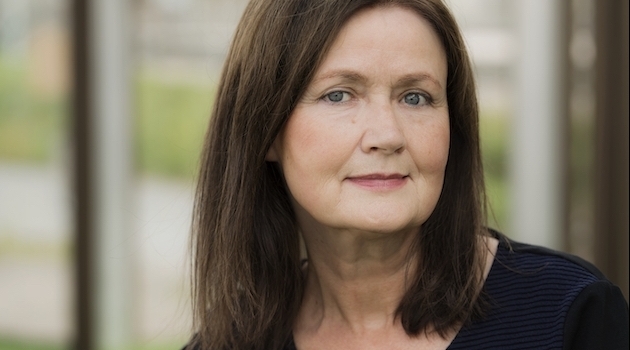She wants to spotlight racial biology
Eva F. Dahlgren has devoted 20 years to studying how science has been used to value people. She started with the history of her own grandfather, Professor Ossian Dahlgren, who lectured at the Swedish Institute for Racial Biological Research in Uppsala. She has now been awarded an Honorary Doctorate in Medicine from Uppsala University.
Eva F. Dahlgren is an author, journalist and lecturer. Three of her books concern the relationship to science, especially genetics, and how the value of humans was perceived during the first half of the 20th century.
The day before the conferment ceremony, when she received her doctoral cap, she lectured in the Humanities Theatre about how the books came into being. It started with a purely personal interest and curiosity about family history.
“I had tremendous admiration for my grandfather. He was the only professor in the family and lived in a flat on Geijersgatan. I always gravitated to the desk where he had a human skull in which he kept paper clips and rubber bands. I never dared to ask whose skull it was, and I regret that now.”
Lectured at the Institute for Racial Biological Research
Her grandfather Ossian Dahlgren was a professor of botany at Uppsala University. Paging through an old binder of clippings, she found a 1948 article in Upsala Nya Tidning (UNT) about his “well-attended lectures” at the Swedish Institute for Racial Biological Research in Uppsala, which was closed 60 years ago.
“I had never heard of the Institute. It came as a shock.”
She also found a 1941 article in UNT in which her grandfather had written that heredity research, plant breeding, population policy and racial hygiene go together.
“In 1935 he also lectured about racial biology for members of the Swedish Parliament. I felt compelled to explore this further. I was a journalist and had been working as a news reporter at the TT News Agency for 10 years. I sometimes wrote about research, but now everything was turned upside down. What is science after all?”
Contact with research in Uppsala
She read newspapers on microfilm and found many examples of “scientific news” about how eminent the Nordic race was. For example, in a Dagens Nyheter article in November 1933 headlined “Nordic Race Skilled at Math”, a genealogist concluded that people from higher social class had larger heads and the more Nordic a person was meant a greater aptitude for math and the natural sciences.
Dahlgren received a scholarship to attend the Department of Medical Genetics at Uppsala University, which had its origin in the old Institute for Racial Biological Research. With Professors Ulf Pettersson and Ulf Landegren as supervisors, she followed the Hugo Project and the mapping of the human genome.
“It was a whole new world, and I learned that a predisposition to disease is in fact quite equitably distributed. There are no superhumans when it comes to genetic predisposition.”
Did not follow his theories
After five years she finished the book Grandfather Was a Racial Biologist in 2002. The book also addresses contradictions in Ossian Dahlgren’s own life choices. Along with Herman Lundborg, a professor of racial biology, he lectured on how “the Nordic Aryan race” was superior to other races, but he married a woman who was only 147 cm tall and was said to belong to “a strange Alpine race”.
“I thought I could perceive him in the context of his time but never understood why he married my grandmother. I would like to think that it was love, and the fact that he did not follow his racial theories is somewhat redeeming,” says Dahlgren.
She continued to dig into the archives, and two subsequent books she wrote deal with “fallen women” and their children. She found police photos of female vagrants and prostitutes who had been incarcerated at the Swedish government’s forced labour institution.
Photos of “fallen” women
The Carolina Rediviva University Library has several thousand images in the race biology archive categorised as Nordic types, Lapps, Jews, twins, criminals and other “inferior” racial types. They include these women from the Landskrona forced labour institution.
“It was common that they had given birth to an illegitimate child and became prostitutes to provide for the child.
It was the 1920s, and there were no contraceptives, possibilities of abortion, child support or childcare. A distant time, but still close at hand. Some of these women lived until the 1980s.”
Dahlgren found a 1925 document from the National Board of Health and Welfare in which the women were divided into 11 different psychological types. Of the 900 women, four-fifths were mentally abnormal according to the National Board.
“What the race biologists and the National Board of Health and Welfare had in common was the assertion that the women became prostitutes because of their genes – that they had a predisposition making it difficult to resist ‘an antisocial way of life’.”
Children sent to foster care
Dahlgren has also investigated what happened to the children of these women. For example, some of them were cared for at Lilla Hemmet in Stockholm, the world’s first asylum for children infected with syphilis. After treating their syphilis with mercury, children declared to be healthy ended up as foster children on Gålö island. No one in the regular foster home market wanted to take in these children, so the farmers were allowed to lease land as an incentive to care for the children. Those branded as “mentally deficient” spent their lives in institutions and were sterilised.
“One of the children died in 2013, which brings us up to our own time.”
In her books Dahlgren asks “Who is of value? Who is inferior, and who determines this?”
“We cannot assess our own time and do not know what our grandchildren will think, but I am glad at least that geneticists have determined that there is no basis for talking about races. Racism still exists, but at least it has no scientific support.
Annica Hulth

